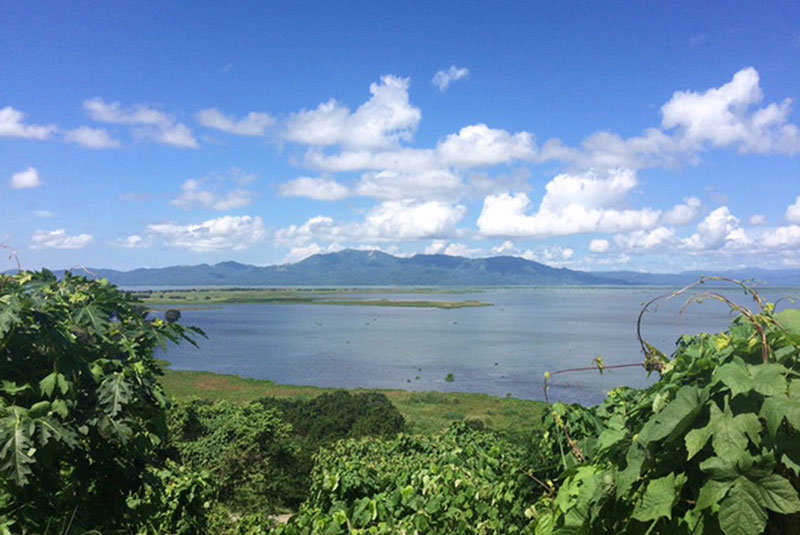Discovering Laguna on a road trip


The view of Laguna Lake from Cavinti. Photos by Bum Tenorio Jr.
There are times when the best vacations are truly found in your backyard. You hop in the car and speed off to a nearby destination you’ve been aching to discover. Then you experience the road trip of your life. The experience is like hitting the Lotto jackpot — because you don’t stop talking about it, and because the experience has made you a richer person in more ways than one.
One early morning, my sisters Michelle Soliven and Jaqui Boncan, our family friend Dr. Marite Vergara and I went on a Laguna road trip. My best friend Bum Tenorio, a proud promdi from Cabuyao, Laguna, was our guide.
Laguna, made up of 24 municipalities and six cities, is a treasure trove of scenic spots, yummy delights, centuries-old churches and nature’s bounty. Every town in the province is a repository of tradition and culture. Laguna offers food for the soul as well as fodder for the stomach.
For example, do you know that there’s a miraculous image of Jesus Christ in the Sto. Sepulcro Shrine of Landayan in San Pedro, the closest part of Laguna to Metro Manila? The faithful believe that if you touch the cord of Tata Uweng, the term of endearment bestowed upon the religious statue, your prayers will be granted. That’s food for the soul.
And as for food for the body, Binan, the next town after San Pedro, is the answer. Of course, you’ve heard about the famed Puto Binan. Wait till you hear about Tony’s Goto in the public market of the city. You visit Binan and you leave the city burping.
Laguna is old and new. And the distance between the old and the new is just a stone’s throw away. The City of Santa Rosa is the theme park capital of Laguna, what with Enchanted Kingdom nearby, while Calamba is home to the historic House of Rizal — and the hot spring resorts in Pansol. (Caution: traffic in Calamba area can test your temper so it is really advisable to leave Manila very early in the morning for the road trip.)
In between Santa Rosa and Calamba is Cabuyao. Almost every week, I get to visit Gulod, a bucolic barrio in Cabuyao, because that’s where my BFF Bum Tenorio is from. Gulod is a lakeside community that offers some of the best scenes of summer akin to many international destinations I have seen. I watched the glorious sunset in Gulod while we were in the middle of the watermelon field. Many times, Bum brought me to the shore and we watched as a herd of carabao (water buffaloes) cooled off in the lake. The sight, though small in scale, was reminiscent of the scene I saw in Tanzania and Zambia during the migration of animals. Another time, I had to rub my eyes when I saw Brahma cows grazing on the verdant grassland by the lake, cinematically reminiscent of New Zealand. Such scenes are feasts for the eyes. But the real feast is always found on the long table under the himbaba-o tree of Bum’s home where his mother, a gifted cook, serves the best sinigang sa bayabas na bangus, hamonado, sinalab na ayungin (grilled fish), ginatang biya, pesang dalag and morcon.
On this road trip, Marite, an OB-gyn, was craving buco pie. So, we stopped by Lety’s Buco Pie and Original Buco Pie, two of the best brands in Anos, Los Baños. Passing the PCAARRD road, we also drove to DTRI (Dairy Training Research Institute) inside UP Los Baños to buy fresh milk and chocolate milk. DTRI also sells cottage cheese, feta and gouda, among other cheeses. Jaqui was so interested to learn about cheese-making that on the spot she enrolled in a three-day class in UPLB.
The UPLB campus, where Bum finished his BA in communication arts, is verdant, enormous and right at the foot of Mt. Makiling. (I will write a separate article on it in the future because UPLB is rich with natural and manmade wonders.)
In UPLB, we drove up to the National Arts Center, a building complex with a land area of 13.5 hectares nestled on top of Mount Makiling that is home to the Philippine High School for the Arts. The steep drive was picturesque as the paved road that led to the Tanghalang Maria Makiling, where the Philippine Philharmonic Orchestra recently performed, was nestled among drooping vines, ferns, dapo plants, fruit trees and hardwood trees. When we reached the top, we rolled out our banig and feasted on buco pie and choco milk. Before us was a beautiful view of Crocodile Lake.
At the National Arts Center, we passed by St. Marc’s chapel where we ogled the chapel’s cross that features the outline of a crucified Jesus designed by Leandro Locsin. And before we left UPLB, we passed by Ginhawa Craft Studio Café, a quaint restaurant cum gallery near the Fertility Tree of the university. A handcrafts fair is ongoing at the café until today (May 14).
A road trip to Laguna is an excursion to the culinary delights of the province. For lunch, we found ourselves in the town of Bae (or Bay), where we indulged in the glorious food of Kamayan sa Palaisdaan. We sampled the restaurant’s sumptuous sinuglaw (grilled tilapia wrapped in mustasa leaves and simmered in coconut milk), grilled squid, ensaladang mangga and sinampalukang manok.
The town is also known for Monay Bae found in Tenorio’s Bakery (perhaps the owners are relatives of Bum because they also came from Batangas, the roots of the Tenorios.) The bread is sold hot over the counter, straight from the brick oven. It goes well with kalamay or coconut jam.
When we reached the town of Victoria, we were greeted by gigantic statues of ducks. Then we smelled duck confit being fried somewhere. Our noses led us to Itlog Ni Kuya restaurant where we had kinulob na itik. This place is heaven, we decided.
We drove past the towns of Pila and Sta. Cruz. The well-paved highways are dotted with potted bougainvilleas among other flowering plants. There were ambulant fruit vendors selling cantaloupe, honeydew melon and watermelon. We stopped to buy the fruits.
Next, the old town of Pagsanjan came alive. On a street lined with old houses, there were people with placards inviting us to try shooting the rapids of Pagsanjan Falls. We contented ourselves watching the colorful boats that passed along the Pagsanjan River from Balanac Bridge. Here’s the deal: push through further past the bridge and you will find Aling Taleng’s restaurant and discover its famous specialty: halo-halo. The sweet flavors of this halo-halo gloriously melt in the mouth.
The town of Lumban comes next after Pagsanjan. Lumban is famous for its intricate and exquisite embroidery. Visit Cris Allen’s Embroidery, for example, for its jusi, piña, and silk fabrics that it fashions into barong Tagalog and long gowns. Using the same materials, a designer gown worth P80,000 in Manila can be had in Lumban for P8,000 made by a local seamstress.
Paete, the woodcarving capital of the Philippines, comes next after Lumban. Artistry is felt in the air as one enters the town of Paete. The sound of chisel and hammer is heard around the vicinity. Woodcarvings of all shapes and sizes are displayed in the stores. There’s also taka or paper mâché.
To be in Paete is to be in arts heaven. We were told that even before kids go to school, they first learn to hold the paet (chisel). For many kids, their toys are a piece of wood that they carve. Paete reminded Bum and me of a woodcarving Alps town in Interlaken, Switzerland that we visited last year.
The towns of Pakil and Pangil were next. We drove along the streets as we raced to catch the setting sun. The view of Laguna Lake from these towns is marvelous, enchanting, enthralling. We needed to stop to watch the sunset. The scene of dusk was subdued but it was sublime. We asked the friendly neighborhood if we could roll out our picnic banig on the rice field overlooking the lake. There, as we bid another day goodbye, we snacked on Monay Bae with cottage cheese and kalamay.
When we had our fill of Monay Bae, we boarded the car and off we sped to the charming, pastoral towns of Siniloan and Famy. In Famy, Bum made us stop to buy big jars of lambanog or coconut wine.
We passed by parts of the very fertile town of Sta. Maria, Laguna before hitting the town of Mabitac. Light and darkness were in steep competition when we reached Mabitac but we still spotted what the town was selling on the road: rocking chairs and baskets made of rattan. There were also pineapples, chicos and avocados, even palm vinegar in plastic containers.
Mabitac was the end of our Laguna road trip. Did we go back to Calamba exit to return to Manila? No. Next to Mabitac is the town of Pililia, which is already part of Rizal. We went home to Makati using Rizal roads. We left Makati for the Laguna road tour at 7 a.m. and by 9 p.m. we were back home.
Bum promises to bring us on another Laguna road trip. Next time, we will pass the route that will lead us to San Pablo (Seven Lakes), Calauan (for the pineapple with kalawang), Majayjay (for the falls), Nagcarlan (for the underground cemetery and espasol), Liliw (for the super-cold running brook and slippers), and other towns.
In a day, on a road trip, Laguna will satiate your wanderlust. This exquisite province will prove to you that some of the best vacations are truly found in your own backyard. For a traveler like me, Laguna is love.
* * *
Email the author at miladay.star@gmail.com.



















